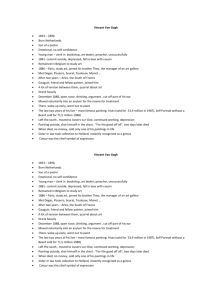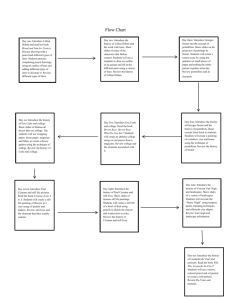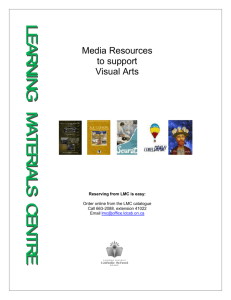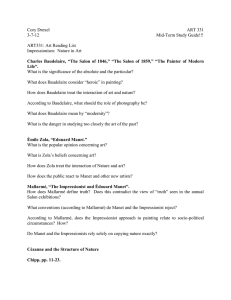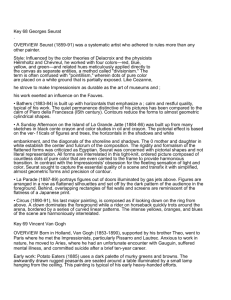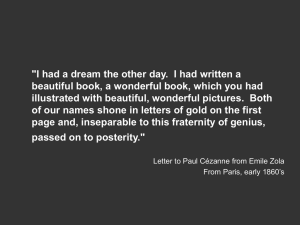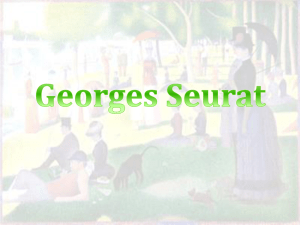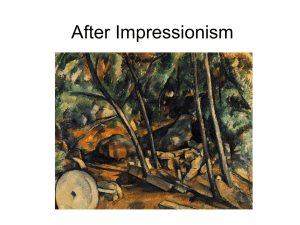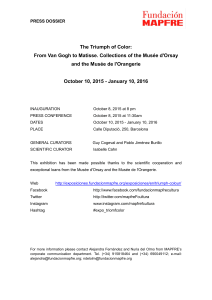Neo and Post Impressionism
advertisement
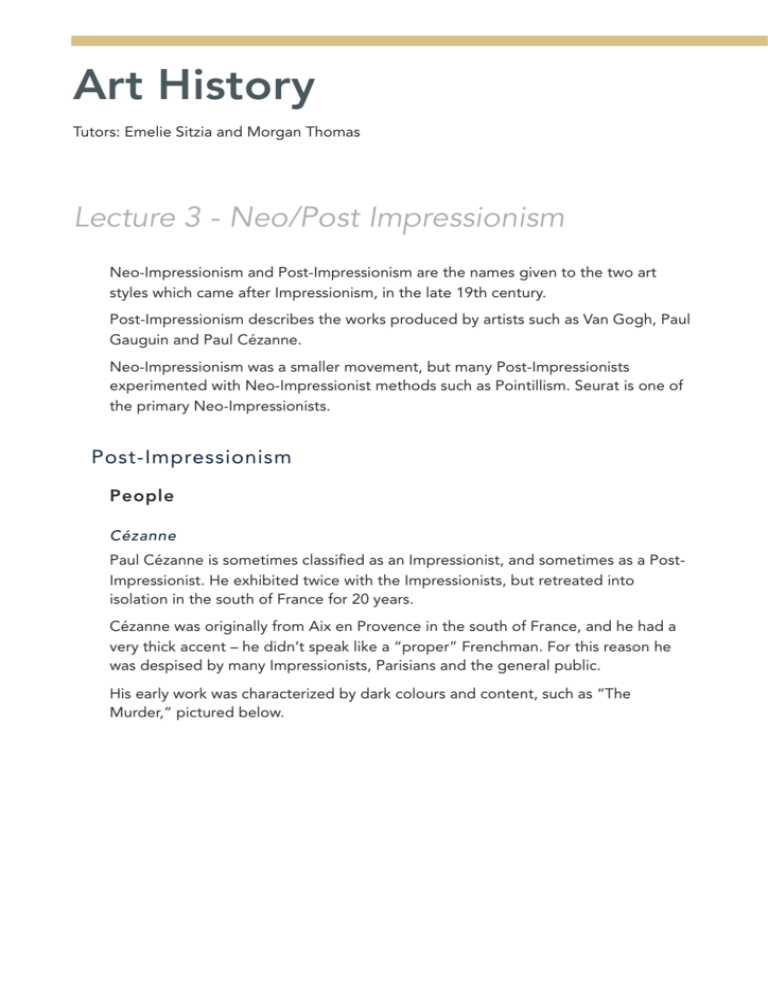
Art History Tutors: Emelie Sitzia and Morgan Thomas Lecture 3 - Neo/Post Impressionism Neo-Impressionism and Post-Impressionism are the names given to the two art styles which came after Impressionism, in the late 19th century. Post-Impressionism describes the works produced by artists such as Van Gogh, Paul Gauguin and Paul Cézanne. Neo-Impressionism was a smaller movement, but many Post-Impressionists experimented with Neo-Impressionist methods such as Pointillism. Seurat is one of the primary Neo-Impressionists. Post-Impressionism People Cézanne Paul Cézanne is sometimes classified as an Impressionist, and sometimes as a PostImpressionist. He exhibited twice with the Impressionists, but retreated into isolation in the south of France for 20 years. Cézanne was originally from Aix en Provence in the south of France, and he had a very thick accent – he didn’t speak like a “proper” Frenchman. For this reason he was despised by many Impressionists, Parisians and the general public. His early work was characterized by dark colours and content, such as “The Murder,” pictured below. Cézanne attended the Academie Suisse. This was a free academy where the artists had to only pay living costs. There were no instructors however, just a model in a squalid room. It was at the Academie Suisse where Cézanne first met Pissarro, who became Cézanne’s friend and mentor. Over the years, they came to work together, not as student and teacher, but as equals. After Cézanne returned from his “exile”, he finally gained acceptance among his peers. “Strange to say, while I was admiring the curious, disconcerting side of Cézanne that I’ve been conscious of for a number of years, Renoir arrived. But my enthusiasm was nothing compared to Renoir’s. Degas himself has fallen for the charm of this refined savage; Monet, everybody.” - Camille Pissarro, in a letter to Lucien Pissarro, 21 Nov 1895. Mont Saint Victoire After moving to the south of France, Cézanne worked mostly on landscapes and still lifes. When it came to landscapes, Cézanne didn’t bother with seasonal variants, or capturing the time of day – all he was interested in was the motif. One of the examples of this can be seen in the progression in style of one of his favourite subjects. The Mont Sainte Victoire. This subject obsessed him – he painted 43 oil paintings of the Mont Saint Victoire, and over 40 watercolours. The first version is very tight and quite Academic. It has a significant amount of depth to it. The second version is a lot flatter, as Cézanne began refining his style, becoming more and more abstract. The final version is defined using almost nothing but geometrical brush strokes. Ambroise Vollard Ambroise Vollard was one of the most important French art dealers of the early 20th century, providing exposure to many artists such as Cézanne, Van Gogh and Picasso. Vollard asked Cézanne to do his portrait – but must have regretted it, hundreds of sittings later! Portrait of Ambroise Vollard - 1899 It can be observed that this painting is very flat – there is one plane for the subject, and one plane for the background. If you look outside the window, you will find that everything out there consists of geometrical shapes. Cézanne has even broken the lighting indoors into geometrical forms. Picasso painted Vollard in 1910 – and if you compare the two side by side, it’s apparent that Cézanne foreshadowed him by 11 years. Still Lifes Throughout most of his life, Cézanne painted still lifes. He was an exceptionally slow painter, and because of this he painted fruit (in particular, fruits which didn’t rot quickly) instead of flowers, because the flowers wilted and died before he could complete the paintings! Left: Still Life with Apples - 1895-98 Right: Table Corner - 1895-1900 While Cézanne often painted the same subjects, he often had very different takes on each. Still Life with Apples is very chaotic, while Table Corner is very geometrical and ordered. Woman with a Coffee Pot Woman with a Coffee Pot - c. 1895 The woman in this painting is also very geometrical. The result of this is that the viewer doesn’t look at her as a human subject, but instead as an object – she bears a resemblance to her coffee pot! Van Gogh Van Gogh was primarily known for his expressive use of line and colour. He was known for being overly emotional – everyone has heard of the story about him cutting off his earlobe and giving it to a prostitute named Rachel after a quarrel with Paul Gaugin. Much of what is known about Van Gogh has been learned from the letters that he wrote to his brother Theo. In the last letter that Van Gogh wrote, he stated that Theo would be much better off financially if he died. Two days later, he walked into a field outside Paris and shot himself in the chest. Impressionist influence on work. The Potato Eaters - 1882 This was painted before Van Gogh had seen any impressionist work. The Night Cafe at Arles - 1888 ...and after. Van Gogh’s work became a lot more expressive as he began to experiment with new techniques. His style was heavily influenced while he was working with Gaugin. Referring to The Night Cafe at Arles, large blocks of colours are apparent – a slight hint of Cloisonnism. Starry Night - 1889 Starry Night is a later example of Van Gogh’s work – getting even more experimental. It was painted while he was at the asylum at Saint-Remy. Two of the standout techniques in this painting are the expressive lines and the “symphony of colours.” Gauguin Paul Gauguin was a painter best known for his Cloissionist influences in his works such as Yellow Christ, and his “primitive” art, influenced by the tropical countries in which he spent many of his years. Gauguin began painting late in his life, under the direction of Pissarro. He lost his job as a stock-broker in Denmark, so he abandoned his family, moved back to France and began painting full time. The Nabis were influenced by Gauguin – he said to Paul Serusier that if a tree was yellow, it should be painted yellow, bright yellow! Van Gogh said of Gauguin. “Certainly [he] will not ask the correct tone of the mountains, but [he] will say: In the Name of God, the mountains were blue, were they? Then chuck on some blue and don't go telling me that it was a blue rather like this or that, it was blue, wasn't it? Good make them blue and it's enough! Gauguin is sometimes like a genius when he explains this, but as for the genius Gauguin has, he is very timid about showing it, and it is touching the way he likes to say something really useful to the young. How strange he is all the same.” Vision After the Sermon – Jacob Wrestling with the Angel - 1888 Gauguin used large blocks of colour in this painting – cloissonism. Compositionally, he cut his canvas between imagination (or vision) and reality by using the diagonal line. Christ Jaune (The Yellow Christ) - September 1889 The Yellow Christ is one of Gauguin’s most well known paintings, and is one of the quintessential examples of cloissonism. This painting has been very flattened - little remains except large blocks of colour and hard outlines breaking them. One interesting thing about this painting is that it is depicting the crucifixion of Christ with modern, 19th century peasants praying. Te aa no areois (the seed of Areoi) - 1892 This is one of the paintings that Gauguin painted after going to Tahiti. His aim was to sell the “dream” of the south seas. Styles Cloissonism Characterized by large chunks of solid colour and dark outlines. Used heavily by Gauguin, and influenced paintings such as The Talisman Paul Sérusier - Landscape at the Bois d'Amour at Pont-Aven - also called the "Talisman" - 1888 Paul Sérusier was a member of Les Nabis, and The Talisman, pictured above, is an example of Gauguin’s influence on him. (Refer back to “If a tree is yellow, paint it bright yellow!”) Symbolism Symbolism was another form of post-impressionism, focusing on non-realistic depictions of ideas. Symbolists were interested in the world of imagination, and decorativeness. Symbolists generally produced decorative works, charged with meaning – but the meaning and narrative was left for the viewer to decide. This resulted in paintings like Jupiter and Semele. Moreau - Jupiter and Semele - 1889-95 Jupiter and Semele is constructed of many, many decorative symbols and motifs. The end result contains much meaning, and is extremely decorative (much in the same way as a stained glass window) but it’s left up to the viewer to decide. Symbolism was a very diverse movement - another symbolist was Redon. Redon Redon took the idea of science in art and ran with it – he read all of the books about natural selection, biological experiments, etc, and created his own imaginary world – see Smiling Spider. Smiling Spider - 1881 (to be honest, I find “Crying Spider” to be far more awesome.) Crying Spider - 1881 Early in Redon’s life, he worked a lot in black in white, with etchings, lithography and charcoal. In the late 19th and earlier 20th century, Redon grew to love colours. He painted Ophelia in 1905. Ophelia - 1905 Ophelia is an interesting example of Symbolism because the image gives you a sense of the story, but only through symbols. The flowers are “becoming one” with her. The paper has humidity stains in it, also hinting at her death. (whether intentional or not.) Neo-Impressionism People Seurat Seurat was an Academy trained artist, who wanted to bring science into paintings. He wanted to update the academic theories, bringing a new style into the academic environment. So, despite his academic training, he painted modern subject matters in a very scientific fashion. He took a very methodic way of approaching this – Seurat began with studies. Studies of characters, studies of landscapes, etc, and he tried to work them together into grand compositions. A Sunday at la Grande Jatte - 1884-86 This painting has a good sense of perspective, as opposed to some of the postimpressionistic works such as Cézanne’s later Mont Saint Victoire paintings. The colours were originally more vibrant, but have faded with age due to the type of paint used. Also on the subject of colour, Seurat defined large areas of colour, such as the dark green, but then he went and mixed different types of dark green, using his dots, for vibrancy. He also has a lot of contrast – see the light green directly next to the dark green. The end result is interesting, because Seurat has taken a traditional subject matter – the garden of love – and given it a modern twist, bringing it into the contemporary world. He has constructed the painting in a solid way, so that there is a sense of order and timelessness. It’s a very idealized society; keeping with academic tradition in that sense. Static Compositions Seurat’s paintings were often very static – including Sunday. Everyone seems posed, frozen like statues. This, however, wasn’t unintentional – Seurat was quite capable of capturing movement, see Le Chahut. Seurat - Le Chahut - 1890 If you look closely, you can see how the image is made entirely of dots, characteristic of Seurat’s pointillist style. He has also experimented with complementary colours. This painting has a lot more motion than A Sunday at la Grand Jatte, proving that Seurat can capture movement – he just often didn’t want to. How has he created movement? ๏ Curves of dresses give sense of motion. ๏ Repeating lines – arms, legs. ๏ Their shadows – remove them and the painting feels far more static. Seurat - Circus - 1890-91 One of the last paintings Seurat painted before he died. Circus was displayed at the Salon des Indepedant. Despite being an academically trained painter, Seurat had strayed too far from tradition to be displayed at the original Salon! Styles Pointillism Pointillism sprang out of the research of impressionism. The impressionist brush strokes were reduced to dots, etc. Unedited Bullet Points ๏ Symbolism • by end of 19th century one of main concepts *leaving* the art world was decadance • the concept that society was going downhill ๏ Key terms ๏ Neo Impressionism ๏ Post Impressionism ๏ Pointillism ๏ Cloissonism ๏ Symbolism
